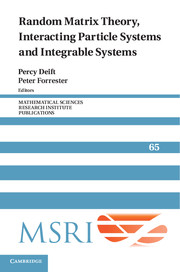Book contents
- Frontmatter
- Contents
- Preface
- Universality conjecture for all Airy, sine and Bessel kernels in the complex plane
- On a relationship between high rank cases and rank one cases of Hermitian random matrix models with external
- Riemann–Hilbert approach to the six-vertex model
- CLT for spectra of submatrices of Wigner random matrices, II: Stochastic evolution
- Critical asymptotic behavior for the Korteweg–de Vries equation and in random matrix theory
- On the asymptotics of a Toeplitz determinant with singularities
- Asymptotic analysis of the two-matrix model with a quartic potential
- Conservation laws of random matrix theory
- Asymptotics of spacing distributions 50 years later
- Applications of random matrix theory for sensor array imaging with measurement noise
- Convolution symmetries of integrable hierarchies, matrix models and τ-functions
- Universality limits via “old style” analysis
- Fluctuations and large deviations of some perturbed random matrices
- Three lectures on free probability
- Whittaker functions and relatedstochastic processes
- How long does it take to compute the eigenvalues of a random symmetric matrix?
- Exact solutions of the Kardar–Parisi–Zhang equation and weak universality for directed random polymers
- Replica analysis of the one-dimensional KPZ equation
- Asymptotic expansions for β matrix models and their applications to the universality conjecture
- KPZ scaling theory and the semidiscrete directed polymer model
- Experimental Realization Of Tracy–Widom Distributions And Beyond: Kpz Interfaces In Turbulent Liquid Crystal
- Random matrices: the four-moment theorem for Wigner ensembles
Asymptotics of spacing distributions 50 years later
Published online by Cambridge University Press: 29 May 2025
- Frontmatter
- Contents
- Preface
- Universality conjecture for all Airy, sine and Bessel kernels in the complex plane
- On a relationship between high rank cases and rank one cases of Hermitian random matrix models with external
- Riemann–Hilbert approach to the six-vertex model
- CLT for spectra of submatrices of Wigner random matrices, II: Stochastic evolution
- Critical asymptotic behavior for the Korteweg–de Vries equation and in random matrix theory
- On the asymptotics of a Toeplitz determinant with singularities
- Asymptotic analysis of the two-matrix model with a quartic potential
- Conservation laws of random matrix theory
- Asymptotics of spacing distributions 50 years later
- Applications of random matrix theory for sensor array imaging with measurement noise
- Convolution symmetries of integrable hierarchies, matrix models and τ-functions
- Universality limits via “old style” analysis
- Fluctuations and large deviations of some perturbed random matrices
- Three lectures on free probability
- Whittaker functions and relatedstochastic processes
- How long does it take to compute the eigenvalues of a random symmetric matrix?
- Exact solutions of the Kardar–Parisi–Zhang equation and weak universality for directed random polymers
- Replica analysis of the one-dimensional KPZ equation
- Asymptotic expansions for β matrix models and their applications to the universality conjecture
- KPZ scaling theory and the semidiscrete directed polymer model
- Experimental Realization Of Tracy–Widom Distributions And Beyond: Kpz Interfaces In Turbulent Liquid Crystal
- Random matrices: the four-moment theorem for Wigner ensembles
Summary
In 1962 Dyson used a physically based, macroscopic argument to deduce the first two terms of the large spacing asymptotic expansion of the gap probability for the bulk state of random matrix ensembles with symmetry parameter β. In the ensuing years, the question of asymptotic expansions of spacing distributions in random matrix theory has shown itself to have a rich mathematical content. As well as presenting the main known formulas, we give an account of the mathematical methods used for their proofs, and provide some new formulas. We also provide a high precision numerical computation of one of the spacing probabilities to illustrate the accuracy of the corresponding asymptotics.
1. Introduction
Random matrices were introduced in physics by Wigner in the 1950s; see [Porter 1965]. Wigner's original hypothesis was that the statistical properties of energy levels of complex nuclei could be reproduced by considering an ensemble of systems rather than a single system in which all interactions are completely described. This allowed for an entirely mathematical approach where statistical properties of the spectrum of an ensemble of random matrices were considered. But coming from physics, the aim was to use mathematics to compute experimentally measurable statistical quantities, and to compare against the data.
One viewpoint on a real spectrum from a random matrix is as a point process on the real line. As such, perhaps the most natural statistical characterization is that of the distribution of the eigenvalue spacing. This choice of statistic becomes even more compelling when one considers that in many cases of interest, eigenvalue spectra can be “unfolded”. This means that unlike many statistical mechanical systems, the density is not an independent control variable, but rather fixes the length scale only. Unfolding then is scaling the eigenvalues in the bulk of the spectrum so that the mean density is unity. It is indeed the bulk spacing distribution for the Gaussian orthogonal ensemble of real symmetric matrices— albeit in an approximate form known as the Wigner surmise (see, e.g., [Mehta 1991])—which was compared against the empirical spacing distribution for the energy level of highly excited nuclei (again, see [Mehta 1991], and references therein).
Information
- Type
- Chapter
- Information
- Publisher: Cambridge University PressPrint publication year: 2014
Accessibility standard: Unknown
Why this information is here
This section outlines the accessibility features of this content - including support for screen readers, full keyboard navigation and high-contrast display options. This may not be relevant for you.Accessibility Information
- 1
- Cited by
